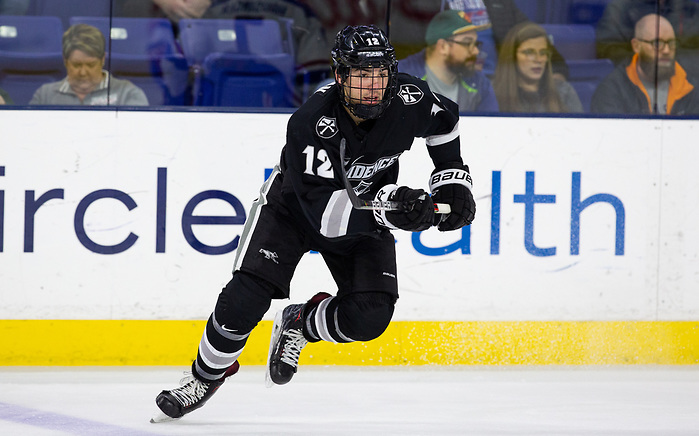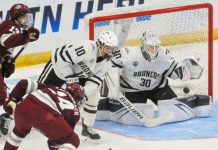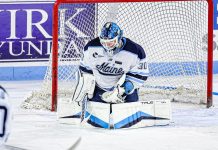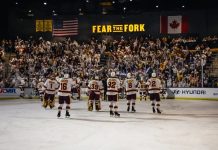
Each week during the season, we look at the big events and big games around Division I men’s college hockey in Tuesday Morning Quarterback.
Jim: Well, Paula, I feel like college hockey is beginning to return to normal with most teams back active after their holiday break.
Still, there was plenty of nonconference play this past weekend, highlighted by a rematch of last season’s national semifinal between Denver and Massachusetts.
This series lived up to its hype as host Denver swept UMass, winning 4-2 and 4-3. They did so having to come from behind each night, trailing 2-1 in the third on Friday and then falling behind 2-0 early on Saturday. Similar to last April’s clash, these were physical games with the two teams combining for 79 penalty minutes over the two nights.
The Pioneers seem to be getting back on track. At one point in early December, they had just one win in seven games. These two wins over UMass give the Pioneers four straight victories and elevated them back to fifth in this week’s USCHO.com poll.
This is more of the Denver team most of us expected when the year began, now, isn’t it?
Paula: Without question, Jimmy.
Denver’s little skid from Nov. 8 through Dec. 7 was against four consecutive ranked opponents — three from the NCHC and Arizona State. After the Pioneers opened their season with eight straight wins, I think we all expected Denver to be dominant over the course of the entire season.
It’s hard to say what happened in that month-long stretch, Jimmy. It could have been the jump in level of play, the adjustment still to new players in the mix, something else that we aren’t privy to – anything, really – but that sweep of UMass and the way in which the Pioneers accomplished that is impressive.
Denver returns to NCHC play at home against St. Cloud this weekend, but the Pioneers have nine of their remaining 16 games on the road in what we know to be the toughest conference in college hockey.
In fact, I’d be surprised if only one NCHC team makes it to Detroit this year. North Dakota begins the second half with a 15-game unbeaten streak and they’re 7-0-1 against four of their remaining opponents. After a rocky-ish start to the season, Minnesota Duluth is once again playing solid hockey. The Bulldogs bookended a midseason break with sweeps of Omaha and Merrimack, scoring 19 goals in those four contests.
Now with Denver finding its feet, the NCHC looks even more powerful.
Jim: The point you make about more than one NCHC team reaching this year’s Frozen Four is an interesting one as right now, only the three teams you mentioned – UMD, North Dakota and Denver – would make the NCAA field.
And at that, Minnesota Duluth’s footing – currently 10th in the PairWise — isn’t exactly rock solid.
That said, I’m not surprised if two of the four No. 1 seeds at the regionals are NCHC teams.
The conference that is in position to place the most teams in the NCAAs is actually Hockey East. Right now, Boston College (fifth in PairWise), UMass (eighth), UMass Lowell (ninth), Northeastern (11th) and Providence (12th) would all qualify for the tournament if the season ended today. That is a result of what is significantly improved play for the conference in nonleague play.
Hockey East is 50-31-12, or a .602 winning percentage, against nonconference opponents, just slightly behind the NCHC (45-26-12, .614). A lot of that is thanks to a dominating .711 winning percentage against ECAC teams. The ECAC, in fact, is really struggling top to bottom. Cornell is a near NCAA lock right now, but teams like Clarkson, Quinnipiac and Harvard are all bubble teams. Clarkson is on the right side of that bubble, while Harvard has fallen below. Quinnipiac, with two wins over the weekend, have improved their PairWise position, but still have ground to make up if they want earn an at-large NCAA bid.
Yes, I know there is still a lot of time for teams to move, but as we approach mid-January, if your team is on the wrong side of the PairWise bubble, it’s time to push the panic button.
Paula: Even though there are coaches that would deny it if asked, there’s no question that there are teams on that bubble that are keying in on ways to improve PWR position and there are teams that discuss ways to remain solid in the PWR in the second half.
There are always two schools of thought about it, at least from what’s publicly discussed: Coaches either zone in on the national championship very closely from the start of the season, always with an eye on the PWR, or there are coaches that think that if they take care of business all season, they’ll be fine.
It seems strange to us, but there are coaches that just don’t look at rankings much throughout the season.
All this talk of the PWR and what may or may not happen in April makes me happy that the Fortress Invitational lived up to its billing, with many in attendance plus players talking about how it had the feel of a regional. The field was fantastic and ended in spectacular fashion, with Providence’s Jack Dugan securing the shootout win for the Friars – in the rink of the team that drafted him.
From that title-game tie to Ohio State needing overtime to beat Army in the third-place game to local high school bands representing each of the participants’ pep bands, I don’t think we could have asked for anything more except for a few more people in the stands.
Jim: I was lucky enough to be in attendance for those games in Vegas and will say that I was impressed by the entire event.
It was well-run, well-organized and, with four nationally-ranked teams in the field, the hockey was excellent. The only thing I could wish for was better attendance. Even though both nights were more than double what last year’s crowds were, 3,500 or so fans in an NHL barn feels empty.
It was ironic to me that the two teams that play in a league without 3-on-3 overtime or shootouts ended up playing in such a situation for the tournament’s championship. I will say that neither coach – Providence’s Nate Leaman and Cornell’s Mike Schafer – enjoyed the title game being decided in a shootout. Both said they would have preferred playing overtime until there was a winner.
And as a purest, that is something with which I agree.
Paula: Anyone who’s followed my writing knows how I feel about any shootout.
It’s not part of the game itself, so it should decide nothing about the outcome of the game. I understand the need to limit the amount of time used for OT in regular-season games to five minutes and awarding each team a point at the end of a tie. I’d be in favor of simply reducing the number of players on the ice in the initial overtime to four or three each side to afford more scoring chances.
I agree with both Leaman and Schafer. Have the teams play until there’s a winner during in-season tournament play. I know that fans find a shootout thrilling, but they find fighting thrilling, too, and no one is making an argument for more fighting in college hockey just to make the game more exciting to fans.
I thought that the NCAA Ice Hockey Rules Committee had a good idea in 2018 to regulate how overtime is conducted all across D-I men’s ice hockey. I do understand that individual conferences want to maintain as much autonomy as possible and that both the NCHC and the WCHA argued for the excitement of the three-on-three following five minutes of five-on-five hockey and the committee reversed its decision.
At this point, there should be some uniformity of overtime in the college game. The shootout employed at any time of the season – in regular-season play, in in-season tournaments – allots disproportionate significance to a skills-based, extra-game activity. In the case of the regular season, teams earn a whole point for “winning” a shootout after both teams had to fight for at least 65 minutes to earn a point each. In a tournament like the Fortress Invitational, a team earns hardware based on the shootout and not the play of the game.
I know I sound like a curmudgeon. I know we’ll never be rid of the shootout. I’d like to see member schools agree to a uniform OT format across D-I men’s hockey.
I just don’t see how different overtime rules for different conferences benefits college hockey.


